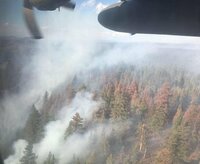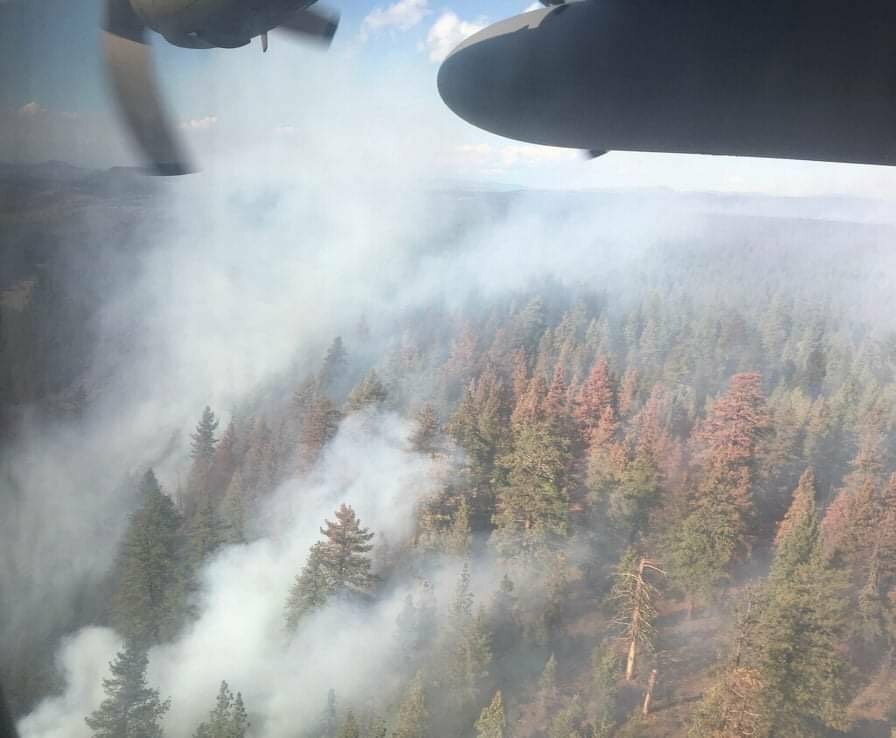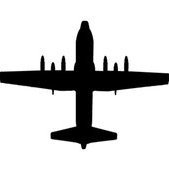

PETERSON SPACE FORCE BASE, Colo. (AFNS) --
The 302nd Airlift Wing has three C-130 Hercules aircraft flying sorties out of McClellan Air Tanker Base this year in Sacramento County, California, performing an aerial firefighting mission unique within the Air Force Reserve.
Since first being activated July 20, the 302 AW has been working together with other military aircraft from Nevada Air National Guard’s 152nd AW, Wyoming ANG’s 153rd AW, and California ANG’s 146th AW to drop millions of gallons of fire retardant in support of fire suppression efforts in California.
On Aug. 25, all eight C-130 aerial firefighting aircraft were activated for the first time since 2012. The aircraft are equipped with a U.S. Forest Service Modular Airborne Firefighting System unit loaded in the cargo bay without requiring any structural modifications to the airframe, enabling crews to drop up to 3,000 gallons of fire retardant in less than 5 seconds over a quarter mile stretch of land.
As of Sept. 12, the combined effort of these units has resulted in the delivery of 23 million pounds of fire retardant through 925 drops over a variety of fires since ANG assistance was first requested June 26. This has been the second highest producing season in the 48-year history of MAFFS. The California Department of Forestry and Fire Protection, or CAL FIRE, the host unit at McClellan ATB, also broke personal records this year by mixing and delivering 6.5 million gallons of fire retardant supporting military and civilian aerial firefighting aircraft alike.
“Everything we do is to support the work accomplished by the crews on the ground,” said Lt. Col. Brad Ross, 302nd Operations Group commander. “With a few rare exceptions, the retardant drops cannot put out a fire on their own, but slow the fire and reinforce lines laid by the firefighters providing a better opportunity to contain the fire.”
Ross said firefighting efforts have been focused on the Dixie, Caldor, Antelope, River Complex, Monument, French and several other smaller fires. Each fire presents its own unique challenge, whether it’s variations in terrain, problems with visibility, or ensuring separation from other aircraft on larger fires. Even though there are well-established procedures preparing crews for these challenges, that doesn’t mean it’s easy.
“Flying MAFFS is the most tactical, challenging flying that we do outside of deployed combat zones,” said Master Sgt. Michael Davenport, 731st Airlift Squadron loadmaster. “Low-level flying in the mountains over ridges and through valleys for retardant drops 150-200 feet above ground level while considering weather and fire conditions requires the best, most experienced aircrews a squadron has to offer.”
Davenport said the most important part of MAFFS is maintaining situational awareness. Each crew member needs to be aware of everything happening around them while flying to and from fires. Everyone is listening to radio calls, watching airspeeds and altitudes, monitoring aircraft and MAFFS systems while communicating with one another every step of the way. Situational awareness and warding off tunnel vision is vital for flying in general, but significantly more important when flying over wildfires.
The number of drops on any given day depends on a wide variety of factors. During calm days with no breeze it’s possible for smoke to linger and greatly impact visibility during flight, limiting the ability of crews to drop. They also don’t fly before sunrise or after sunset because it adds another layer of risk to an already challenging mission. But, when conditions are right, it’s possible for one crew to perform 15 drops in a single day.
Everybody needs to be ready to go within minutes in case a launch order is called for, and crews are often on standby until sunset. Each drop involves a coordinated effort between aircrew, maintenance teams, CAL FIRE ground crew and the U.S. Forest Service to ensure the process goes as smoothly and safely as possible, from the moment the aircraft starts to the moment the fire retardant is discharged.
“All of us take a tremendous amount of pride from being a part of flying the MAFFS mission,” Davenport said. “Every year we see firsthand what kind of destruction wildfires can cause, so it’s an honor to be part of a larger effort to stop them and keep people safe.”
At one point during the season, all eight military aircraft were airborne at the same time working together to fight the Dixie fire on its eastern and western zones. Ross said it can be challenging maneuvering that many aircraft at once during the loading pits when they come down to refill their MAFFS tanks.
“The time commitments from our maintenance and operations personnel on scene are significant,” Ross said. “Our stated mission is to supply two planes and crews, but now we’re providing three and doing so very successfully. Our C-130s have retained a remarkable mission capable rate due to the hard work and dedication from the 302nd Maintenance Group, and getting large amounts of people and equipment out to support the operation doesn’t come together without the help of nearly every unit in the 302nd Mission Support Group.”
Ross said the amount of drops happening wouldn't be possible without the extensive efforts of the 302nd MXG team committed to keeping the aircraft flying. Of the three aircraft the 302nd AW has supplied to the firefighting efforts, only one has been down so far due to maintenance issues which were resolved quickly. Another aircraft was down for a major inspection that takes a week during normal operations, but the team finished in just four days. Maintainers have been providing a 100% aircraft commitment rate for two months, which is unheard of according to Ross.
Lt. Col. Richard Pantusa, 302nd AW aerial firefighting chief, said crews flying C-130s work alongside other aircraft such as federally-activated large and very large air tankers, Air Force RC-26 infrared imaging platforms, helicopters, aerial supervision and water scooper aircraft. They also work together with California State S-2 trackers and OV-10 broncos, helicopters and various other manned and unmanned planes. Aircraft from as far as Australia have been joining the fire suppression efforts this year.
“It required careful coordination between wing leadership, our partner wings in the ANG, and the National Interagency Fire Center, to ensure that we were able to support the requirements of the firefighting effort this year,” Pantusa said. “Our MAFFS team never ceases to amaze me, with many of our operations, maintenance, and logistics folks jumping-in with overwhelming motivation to do this mission well.”
Only experienced aircrew are eligible to become qualified to perform the dangerous aerial firefighting mission, said Pantusa. They’re selected from within the 731st AS aircrews and require several years of flying experience in a variety of deployed and domestic operations prior to meeting the initial MAFFS qualification threshold. Once they meet the requirement, they’re trained during an annual training event hosted by the U.S. Forest Service. All MAFFS-certified crews attend this training every year.
The 302nd AW has 10 MAFFS-certified crews prepared to support the mission with three currently flying, swapped out weekly.
In the 1970s, Congress established the MAFFS Program to aid the United States Department of Agriculture Forest Service. Typically, when all other civilian air tankers are activated but further assistance is needed, the U.S. Forest Service, through the National Interagency Fire Center, can request the aid of the U.S. Air Force's MAFFS flying units.
MAFFS is a mission that highlights interagency cooperation. The 302nd AW works in concert with NIFC and the U.S. Forest Service. NIFC serves as a focal point for coordinating the national mobilization of resources for wildland fire. When it is determined MAFFS will be utilized, NIFC through U.S. Northern Command requests Air Force resources.
Pantusa said conditions for wildfires in 2021 are at elevated levels over large portions of the Western United States, and all types of resources have been activated to support the national effort.
The military aerial firefighting efforts are expected to continue through to the end of October.
View original article: Reserve C-130 aerial firefighting teams fly during second busiest wildfire season > U.S. Air Force > Article Display (af.mil)


Recommended Comments
There are no comments to display.
Join the conversation
You can post now and register later. If you have an account, sign in now to post with your account.